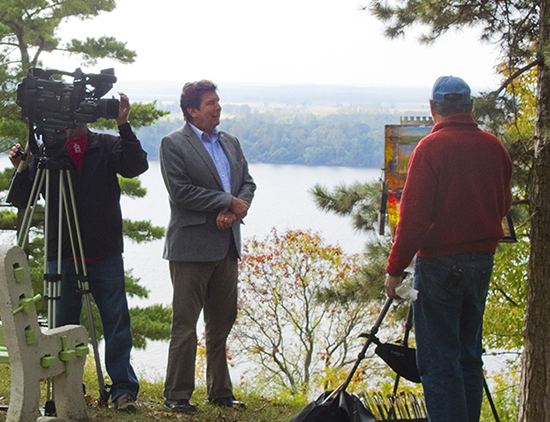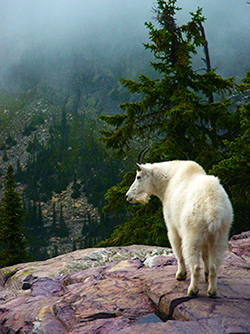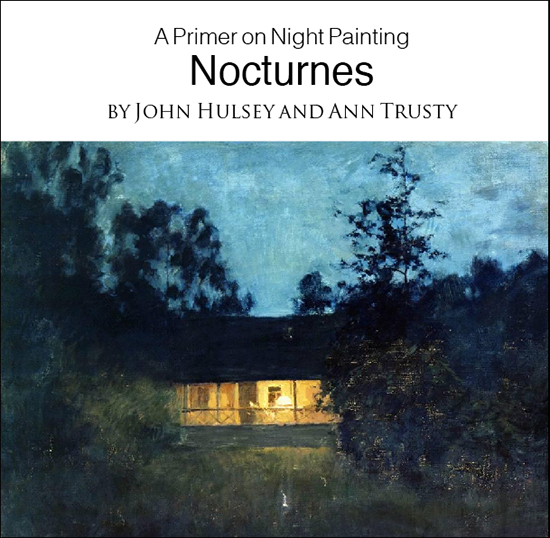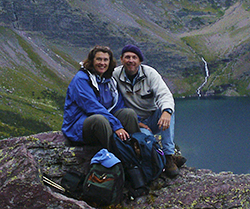Voices of Experience
Richard K. Blades
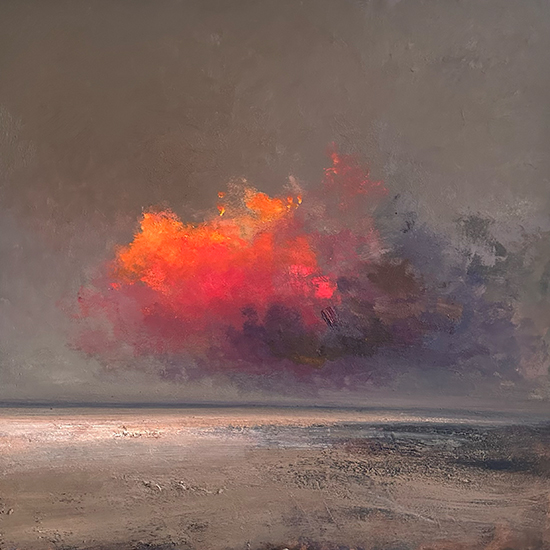
Sunday's Cloud 30 x 30" Oil
". . . the landscape is always there,
as something eternal, the ever-changing muse,
always present, yet never the same.”
Richard K. Blades describes himself as, ". . . primarily an expressive landscape artist, painting in the English Romantic tradition." His works capture essences—the brief powerful moment of sunset, the final lingering light of dusk and the brilliant burst of color in a spring blossom. His love affair with the light, the land and the sea is translated into paint—a gift to the viewer who is invited to walk with him along the coastline and to witness the power of Nature. In addition to painting, Blades teaches and owns a gallery in Cromer, Norfolk, UK, called The Point Contemporary.
We asked Blades to tell us more about his inspiration, his processes and his evolution as an artist.

Did your family encourage your creativity when you were growing up?
My family has always been very encouraging of my creativity, and it continues to be so. Though my parents aren’t creative in the artistic sense, they are very passionate about their interests and careers. Both are former teachers, as well as being writers, and this passion and drive have been so integral to how I see my life. They came from working-class backgrounds and were the first in their families to go to university. A strong work ethic and a passion for learning are at the core of how they approach life and how they brought my brother and me up. When it came to Art, my grandmother took up painting later in life. It was an amazing thing to see, and she definitely had an influence on my wanting to paint. By the time she passed away, her apartment walls were covered in paintings, landscapes, still lives and portraits. I often think how nice it would be for her to see where I am now and for her to know that I feel the same passion and excitement about painting as she did.
I’m primarily self-taught. I have a degree in Fine Art, but like many Academic programs nowadays, the course was taught mainly by conceptual artists and geared towards that approach. I didn’t paint at all in my course, but I still appreciate that it gave me the opportunity to think a lot and explore ideas, and this helped me understand and write about my work later on. When it came to painting, I learnt the hard way, through trial and error. This came through a combination of practice and visiting the galleries of London. I learned so much from being up close to Turners, Constables and Whistlers.
Alongside this, I also became friendly with professional artists and watched how they worked. Understanding the mindset and drive of artists was such an important part of my own journey. From them, I learned that one has to turn up, inspired or not, and that life as an artist was not an easy one. Learning how to harness and direct passion and inspiration can be a major part of success.
Have you taken workshops from other artists that have inspired your work?
Despite running workshops and teaching classes myself, I have never taken a workshop by another artist. I think it’s because my learning style has always been different. I like to work things out in my own way, and whilst this has helped me greatly, I’m sure it has its downsides too!
There is a lot to be learned, both practically and theoretically, from workshops. Hopefully, in the future, I’m going to start life drawing classes. I really want to explore figurative painting and develop it into my practice. I’m mostly interested in the idea of figures within interiors, along the lines of Bonnard or Vuillard. If I could travel back in time, I would definitely attend one of their workshops!
When were you first able to pursue your fine art painting full-time?
It took a long time to get to that stage. I was in my late 30s when things started to come together, and I was able to become a full-time artist. In many ways, I was a full-time artist throughout my 30s, but I just made little money from it! I have always balanced things out with running courses and workshops. This helps pay the mortgage, and I’m able then to paint what I want, instead of what I think would sell.The teaching went from three days a week to just one evening a week. Although I am involved in other interests, such as curating, the rest of my time is dedicated to painting.
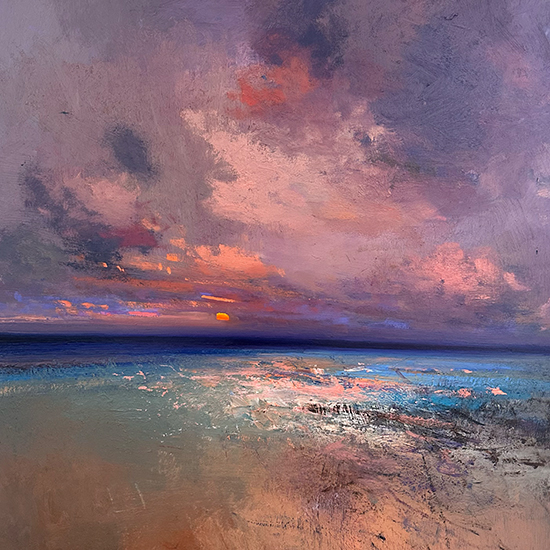
The Things We Found 30 x 30" Oil
My way of working is interesting in that I mainly paint from memory/imagination. I live next to the sea and spend a lot of time walking in and observing nature, in particular, the sea and sky. Whilst I do make sketches and also paint en plein air, most of my work is started when I return to the studio, my head full of inspiration. I feel this connection to nature that is both emotional and creative. It is full of memories and longing. The landscape, for me, is the ever-changing muse. Certain elements remain the same, but the seasons, light and weather all influence it in ways that I strive to capture. If the landscape represents the body, then these shifts and changes represent the emotions. Atmosphere, in this sense, is a very important part of what I’m trying to convey. I want to be able to capture moments that resonate with the viewer, and I have found that to do this, I have to go beyond the merely representative.
I don’t work from photographs. I take a lot of them, and I’ll sometimes use them for inspiration, but for me, photography and painting are two separate languages. My compositions are rather simple, and one can internalise the basic landscape compositions. The rest comes from the atmospheres I harvest when out on my walks, and this then enters a dialogue with the materiality of paint.
I arrived at a more representative subject matter through abstraction. For many artists, it’s often the other way round, gradually moving towards abstraction from representation. My early interests in painting were the St. Ives School (Cornwall, UK) and Abstract Expressionism. After living in Cornwall and Devon, I moved to London. I was painting in an abstract way, but not really finding my voice. I think, in many ways, I was just emulating a visual language that I had become fascinated with. However, this helped me learn about the physical qualities of paint, of surface and a sense of depth and tactility. Sometimes we don’t realise that this is all part of the creative process, the looking, searching and shifting.
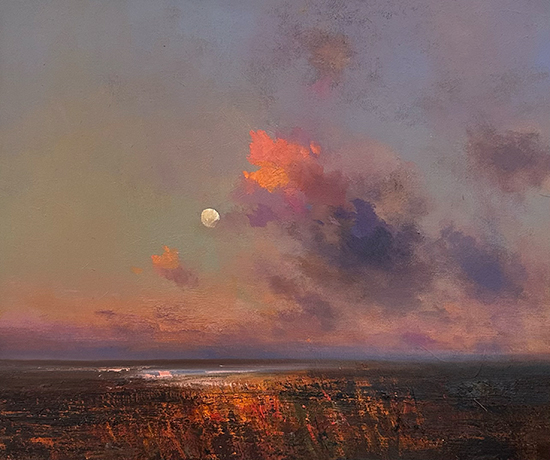
Still (Always) 24 x 20" Richard K. Blades
It was only when I started to return to the countryside on frequent trips out of the city that I began to rekindle my relationship with the landscape, a relationship that had been there ever since my early days, growing up in the East Anglian Fens. I began to see the landscape through this romantic lens, one of longing, and it became very inspirational. This is when I started to explore the Romantic Period of British landscape painting and really related to it. During the Industrial Revolution, so many people flocked to the cities, and the natural landscape began to take on an almost divine quality. This is how I was feeling: that nature had an appeal beyond the pictorial, it was the opposite of my life in the city, and I wanted to create paintings that embodied that essence.
Travel to other parts of the world has played a role in your art. Where did you most find inspiration for your landscape work?
I spent a good deal of my twenties traveling. During this time, I wasn’t painting but just absorbing everything. I truly think that everything we see and experience, directly or indirectly, informs our work. Things that manifest and reveal themselves, maybe subconsciously, and it’s only recently that I began to see that my colour choices were partly informed by my journeys to India. European landscape painting tends to reflect the natural colours of the environment, but I have always been interested in turning the dial up a little, having these pops of pink, orange and purple. India is a place that is full of colour and texture, I’ve also always had a love of Indian Art, especially miniature paintings.
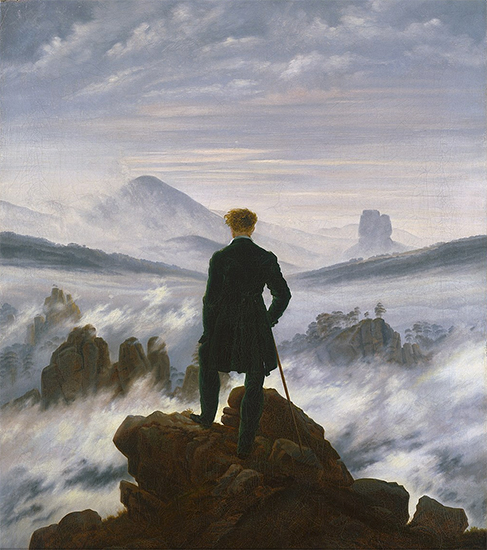 In my 20s I hitchhiked across Canada and also parts of Europe and Australia. The vastness of Canada—to be alone on the side of the road surrounded by this huge sky and landscape. This is most definitely a theme in my painting, also, the sense of space and contented isolation, of being in communion with nature through this solitude. Up until this point, I have never included figures in my landscapes. I want them to be experienced in a very personal way. That the viewer is not looking at a figure experiencing the landscape, as in Caspar David Friedrich’s Wanderer above the Sea of Fog (left) or Gustave Courbet’s The Seaside at Palavas (below). Instead, it is we who are experiencing nature. We are the wanderers.
In my 20s I hitchhiked across Canada and also parts of Europe and Australia. The vastness of Canada—to be alone on the side of the road surrounded by this huge sky and landscape. This is most definitely a theme in my painting, also, the sense of space and contented isolation, of being in communion with nature through this solitude. Up until this point, I have never included figures in my landscapes. I want them to be experienced in a very personal way. That the viewer is not looking at a figure experiencing the landscape, as in Caspar David Friedrich’s Wanderer above the Sea of Fog (left) or Gustave Courbet’s The Seaside at Palavas (below). Instead, it is we who are experiencing nature. We are the wanderers.
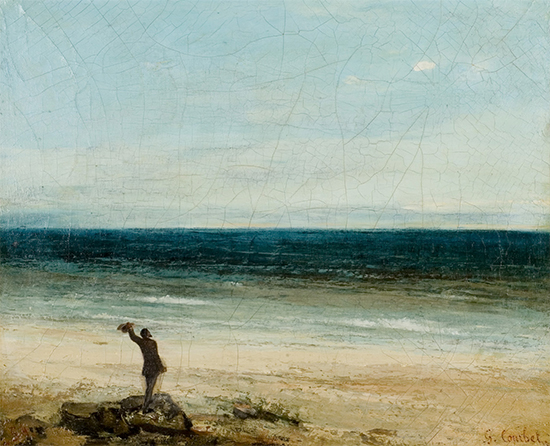
Would you tell us a bit about your process?
Whilst I do make and occasionally work from thumbnail sketches, I see myself more as a process painter. In that sense, the painting takes its own journey and is a conversation I’m having with the materiality of the paint as much as an image I want to create, and whilst I have an idea in mind, the painting can change drastically throughout its creation.
When it comes to materials, I keep it quite simple. In the beginning, I believed that the better the quality of the paint or the more specialised the brushes, the better I would paint. Whilst it is true that quality materials do make a difference, it is always better to start simple and then expand. For example, I mainly use a limited palette of three primary colours. This has taught me more about colour than using an expanded palette. My go-to palette is Ultramarine Blue, Permanent Rose, Cadmium Yellow and Titanium White. However, I will often switch these around—Cobalt Blue, Burnt Sienna, Yellow Ochre, or, Cerulean Blue, Cadmium Red, Indian Yellow. I love to experiment with colour triads in this way. This isn’t to say that I only use three colours, I’ll often add a colour when needed.
I avoid using mediums and prefer to use the paint as it comes out of the tube. Sometimes I’ll use a little solvent or Liquin on larger paintings, and sometimes I’ll glaze a little also, but mainly I prefer dry brushing, so the thicker the paint, the better.
I use a mix of bristle brushes, a palette knife and rags to paint.
I usually paint on Masonite panel and sometimes canvas for my oil paintings, and hot-pressed paper for my gouache paintings.
Due to how I work, it’s quite difficult to show a step-by-step process, but I’m happy to share this painting, Sunday's Cloud, and explain how it arrived at a finished piece.

Sunday's Cloud 30 x 30" Oil
Sunday’s Cloud is 30 x 30”. Recently, I have shifted towards painting on this scale. It is a different experience from painting smaller. The majority of my smaller works are alla prima, but on a larger scale, I find that paintings develop in a different way.
The inspiration for this painting was a cloud that I saw whilst out walking one Sunday at low tide. The atmosphere created by the fading evening light was incredible. I wanted to capture this moment.
In the painting, I looked to create a very minimal but rich feel. The surface of the painting shows the history of this process. Although simple in compositional terms, there was a process of reducing interest in the sky and foreground so that the cloud would be the main character. For this, I scumbled muted layers to create an almost flat but alive surface.
I tend to work on a painting in a holistic way, moving around and adding bits here and there. The horizon line is something I keep going back to, reinforcing it as something that anchors the scene. I find that by having this in what, in many ways, is an abstract space, it gives the painting a recognisable dimension and a geometric framework.
I built the cloud form throughout the painting process, increasingly adding stronger values as I went along. I tend to work in mid-tones initially and then move towards more contrast in response.
When I paint clouds, I really enjoy the mark-making aspect. I know that if I have my values right, I can be more expressive with the brush marks.
Are you currently teaching workshops?
Yes, I currently run online courses for Penn Studio School of Art and Winslow Art Center. Some examples of recent courses are
Learning from Turner
Exploring Color: The Limited Approach to Expressive Painting
Mark Rothko and the Landscape
Expressive Landscapes in Gouache
I also run occasional in-person workshops in the UK.
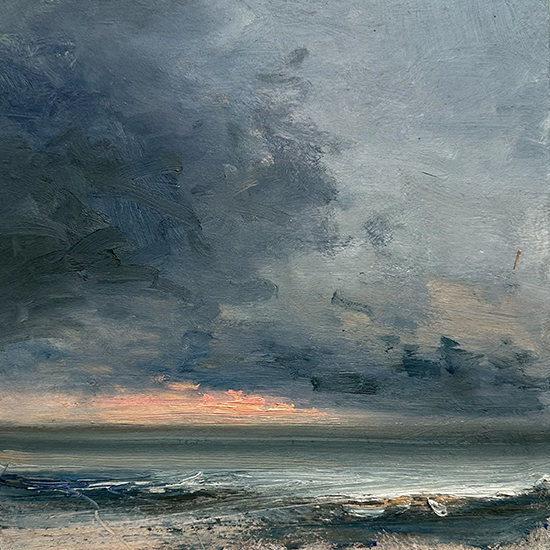
Last Light Oil
Any words of wisdom you might give to beginning artists?
It can be a long path, but the journey is well worth taking. I would always recommend to just painting, painting as much as you can and creating as many paintings as you can. Working small, rather than large, in the beginning can really accelerate the knowledge of the medium. The more we paint, the more we understand painting. In that sense, ten small paintings created in the time of one large one gives a developmental advantage. Something else that I think is important is that we do not try to ‘complete’ paintings. Take it as far as you can and then leave it, solve some of those issues in the next painting. Working in this way means that the artist solidifies what they have already learned and can then take more confident steps into the unknown.
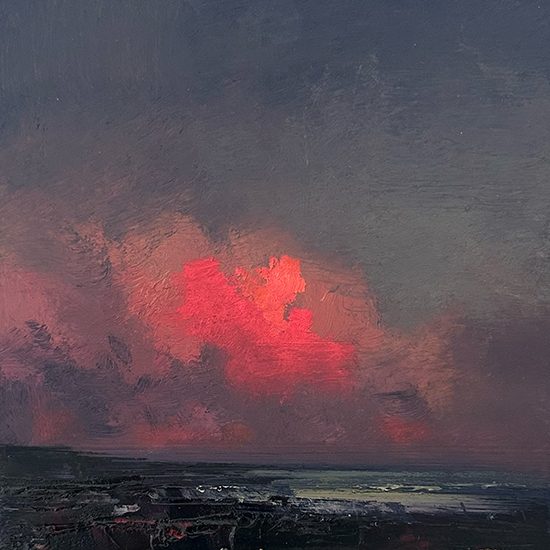
The Last Cloud 8 x 8" Oil
Successful artists have a style, and this is really just a representation of repetition. Repeat yourself, soon you will start to find that you can do this, but also say something different, albeit with the same voice.
And, just for fun, if you could sit down and have a long conversation over dinner with an artist from the past, who would you choose, and why?
This is a difficult one as there are so many! I think today I would have to choose Turner. I am particularly interested in his later work and I would love to know what he was feeling, envisioning when he pushed his work more towards abstraction. It was a very bold thing to do at the time and really only appreciated and understood after his time. Turner was a complex but fascinating person.
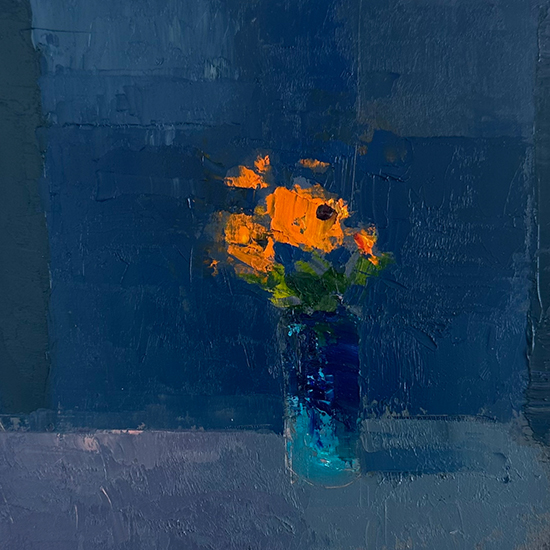
Welsh Poppies 8 x 8" Oil
To see more of Richard K. Blade's paintings
go to: Richard K. Blade Artist
All images © Richard K. Blade



 In my 20s I hitchhiked across Canada and also parts of Europe and Australia. The vastness of Canada—to be alone on the side of the road surrounded by this huge sky and landscape. This is most definitely a theme in my painting, also, the sense of space and contented isolation, of being in communion with nature through this solitude. Up until this point, I have never included figures in my landscapes. I want them to be experienced in a very personal way. That the viewer is not looking at a figure experiencing the landscape, as in Caspar David Friedrich’s
In my 20s I hitchhiked across Canada and also parts of Europe and Australia. The vastness of Canada—to be alone on the side of the road surrounded by this huge sky and landscape. This is most definitely a theme in my painting, also, the sense of space and contented isolation, of being in communion with nature through this solitude. Up until this point, I have never included figures in my landscapes. I want them to be experienced in a very personal way. That the viewer is not looking at a figure experiencing the landscape, as in Caspar David Friedrich’s 



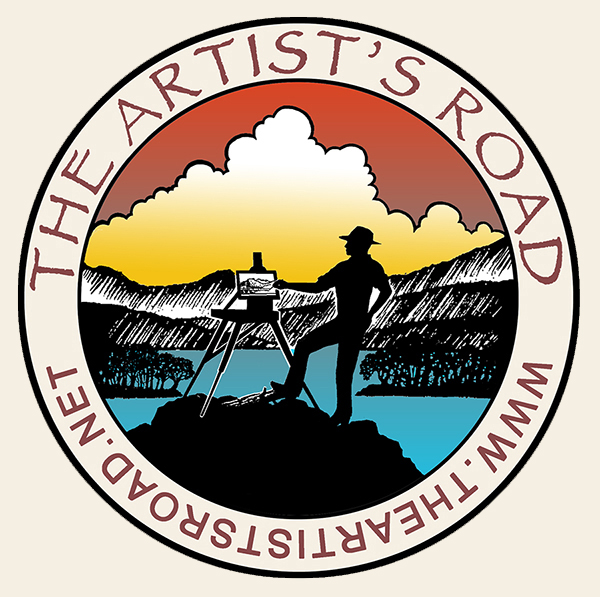

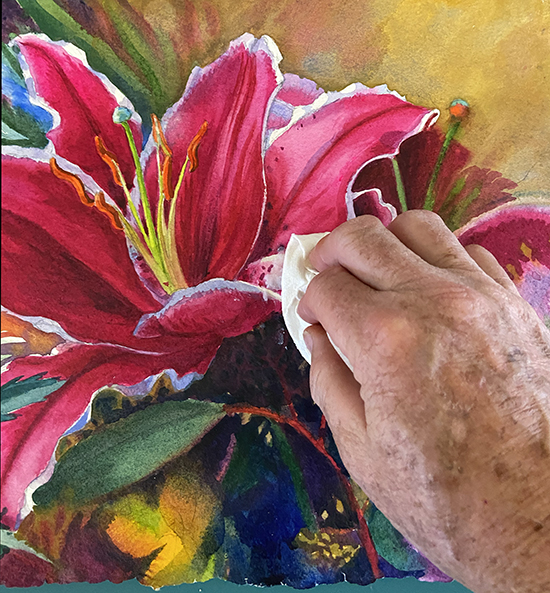 ing Watercolors
ing Watercolors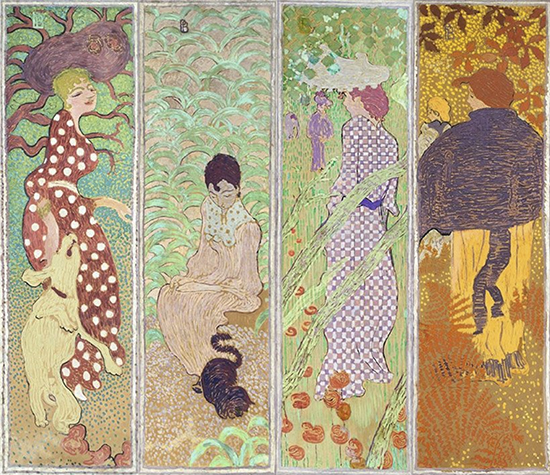
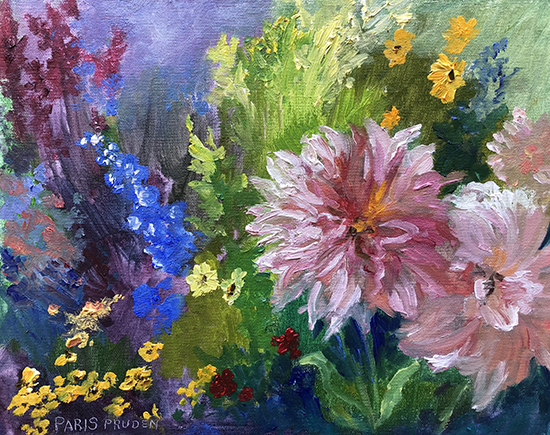
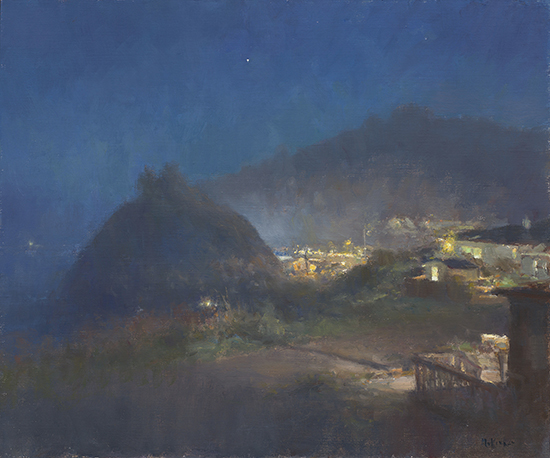 Nocturne Notes
Nocturne Notes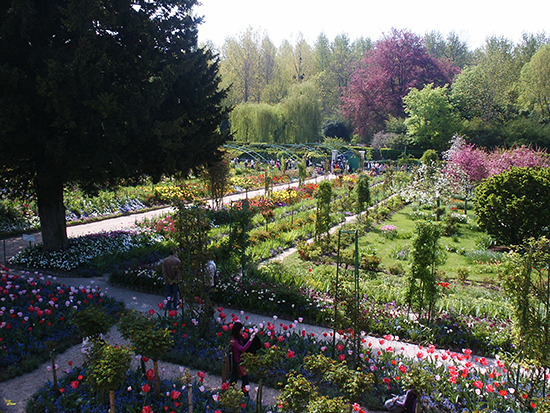 Inspiration in Monet's Gardens
Inspiration in Monet's Gardens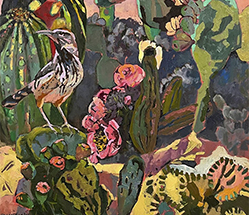
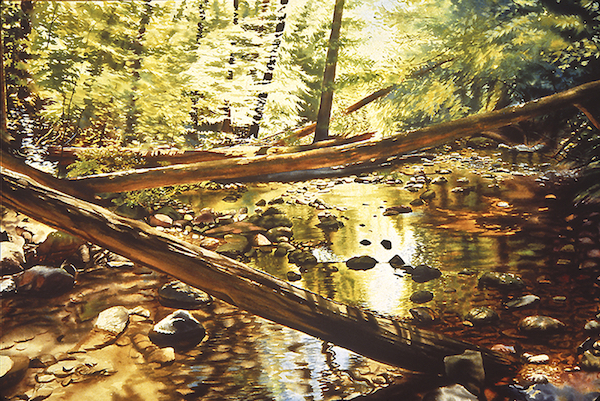 The Watercolor Medium
The Watercolor Medium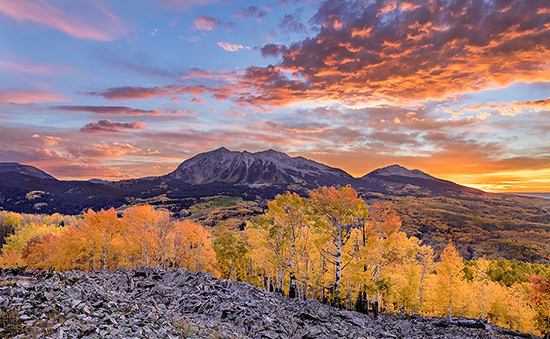
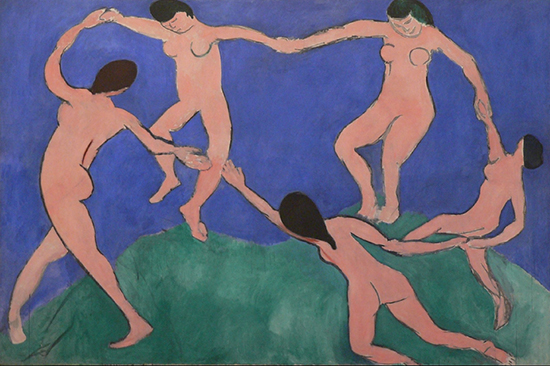 The Perspectives Archive
The Perspectives Archive